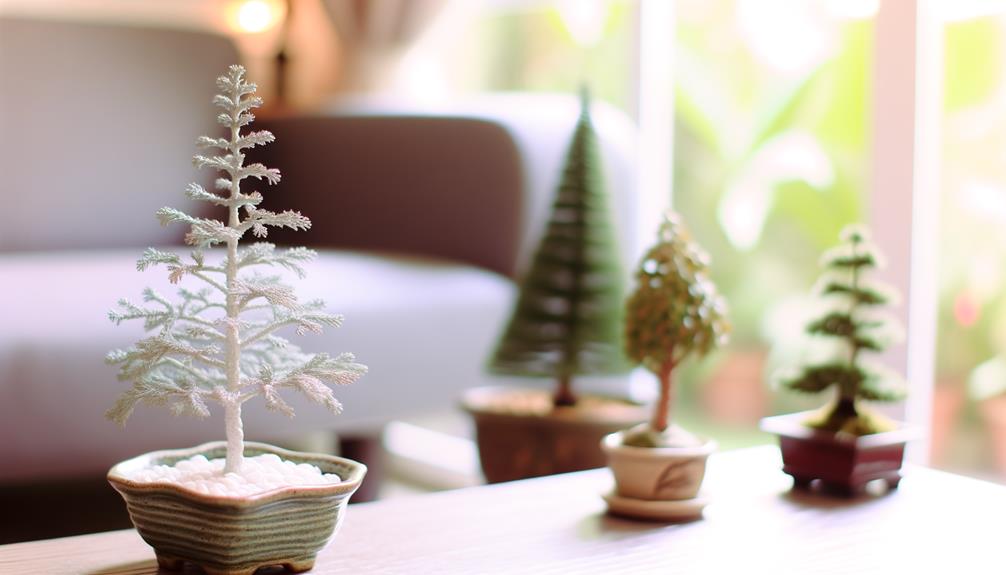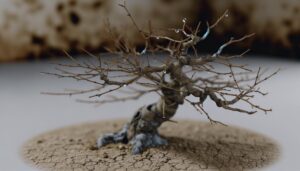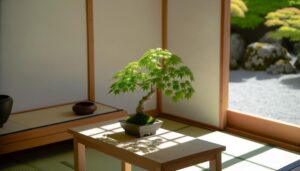How You Can Bonsai a Christmas Tree Step by Step
Yes, you can bonsai a Christmas tree using precise horticultural techniques and by selecting species with appropriate physiological traits. Choose trees with dense needle foliage, a compact growth habit, and fibrous root systems for best adaptability to bonsai cultivation.
Employ essential techniques such as strategic pruning, wiring, and meticulous root management to shape and control the tree's growth. Seasonal care variations, including adjustments in watering, light exposure, and nutrient requirements, are essential.
Challenges include pest control, maintaining nutrient balance, and managing environmental stressors. This intricate process offers aesthetic appeal and requires a thorough understanding of plant physiology for continued success.
Learn more about the detailed steps and benefits involved.

Key Takeaways
- Yes, Christmas trees like pines and firs can be bonsaied using essential bonsai techniques.
- Choose species with dense needle foliage and compact growth habits for best results.
- Employ regular pruning, wiring, and root management to shape and maintain the tree.
- Seasonal care is crucial, requiring adjustments in watering, light, and nutrients.
- Bonsai Christmas trees offer aesthetic appeal and enhance horticultural skills.
Choosing the Right Tree

Selecting the appropriate species for a bonsai Christmas tree involves understanding the physiological traits and growth patterns of various coniferous trees. Species such as Picea abies (Norway spruce) and Pinus sylvestris (Scots pine) are frequently chosen due to their dense needle foliage and compact growth habit. These species exhibit apical dominance, a trait essential for maintaining the classic triangular form associated with Christmas trees. Additionally, their hardy nature allows for extensive pruning and shaping.
Understanding the root structure is also vital; species with fibrous root systems, like Abies balsamea (Balsam fir), adapt well to confined containers required for bonsai cultivation. Hence, the selection process must consider both aesthetic potential and the tree's physiological adaptability to bonsai techniques.
Essential Bonsai Techniques
Mastering essential bonsai techniques demands a thorough understanding of pruning, wiring, and root management methodologies to effectively shape and maintain the desired aesthetics of a miniature Christmas tree.
- Pruning: Strategic removal of specific branches and foliage to promote desired growth patterns and maintain scale.
- Wiring: Application of aluminum or copper wire to branches and trunks to guide and stabilize growth direction.
- Root Management: Regular root pruning guarantees a compact root system, facilitating a smaller growth habit and healthier root environment.
- Soil Composition: Utilizing well-draining soil mixtures tailored for conifers to ensure best nutrient uptake and prevent root rot.
These techniques, when meticulously applied, encourage the aesthetic and structural integrity of a Christmas tree bonsai.
Seasonal Care Tips

For peak health and growth, a Christmas tree bonsai requires specific adjustments to its care regimen according to seasonal variations. Each season presents unique environmental conditions that influence watering schedules, light exposure, and nutrient requirements. During spring, the active growth phase necessitates increased watering and fertilization. Summer demands careful monitoring of soil moisture and protection from excessive heat. Autumn is a critical period for preparing the bonsai for dormancy, gradually reducing water and stopping fertilization. Winter care focuses on maintaining dormancy, ensuring minimal water and protecting from frost.
| Season | Watering Frequency | Light Exposure |
|---|---|---|
| Spring | Increase | Full Sun |
| Summer | Moderate | Partial Shade |
| Autumn | Decrease | Full Sun |
| Winter | Minimal | Indirect Light |
Common Challenges
Caring for a Christmas tree bonsai can present several challenges, including pest infestations, nutrient imbalances, and improper watering techniques. These challenges often stem from the tree's miniature size and unique environmental needs.
- Pest Infestations: Bonsai trees are susceptible to aphids, spider mites, and scale insects. Regular inspections and appropriate pest control measures are essential.
- Nutrient Imbalances: Due to limited soil volume, maintaining ideal nutrient levels is crucial. Fertilize with balanced, slow-release formulations.
- Improper Watering Techniques: Overwatering can lead to root rot, while underwatering can cause desiccation. Employ precise moisture monitoring.
- Environmental Stress: Temperature fluctuations and inadequate light can stress the tree. Maintain stable conditions and appropriate light exposure.
Addressing these issues requires diligent observation and tailored care strategies.
Benefits of Bonsai Christmas Trees

Bonsai Christmas trees offer a unique blend of aesthetic appeal and horticultural challenge, often providing the opportunity to cultivate refined pruning and shaping techniques. These miniature conifers are not only visually striking but also serve as living embodiments of botanical art.
The meticulous process of bonsai cultivation enhances one's understanding of plant physiology, particularly in relation to dormancy periods, root pruning, and nutrient management. Moreover, the compact size of bonsai Christmas trees makes them ideal for urban dwellers with limited space. They can be displayed indoors, offering year-round greenery and a festive ambiance during the holiday season.
Additionally, the practice of bonsai fosters mindfulness and patience, contributing positively to mental well-being. This way, bonsai Christmas trees present both horticultural and psychological benefits.
Conclusion
The cultivation of bonsai Christmas trees necessitates an intricate balance of horticultural expertise and artistic vision, akin to a sculptor chiseling a masterpiece from a marble block.
Through the judicious selection of species, application of precise bonsai techniques, and adherence to seasonal care protocols, one can overcome common challenges and reap the multifaceted benefits.
Ultimately, the pursuit of bonsai Christmas trees offers a harmonious blend of aesthetic beauty and botanical science, enriching both the grower and the observer.






